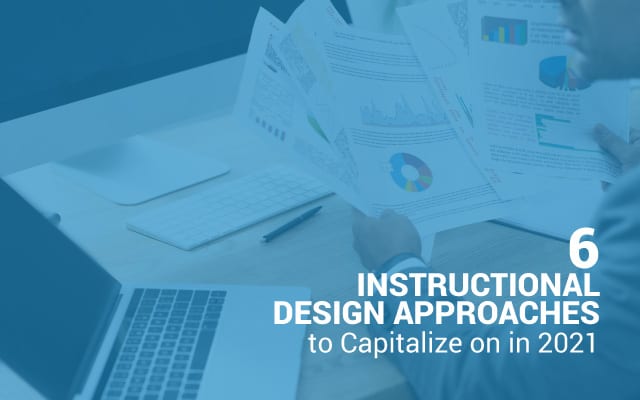Continueing Education for Instructional Media Designers

by Salma Torres of Skyepack
For continuing education, professional development, and lifelong learning providers, it's vital to consider not only the content of educational courses but also the way in which material is presented. Effective, thoughtful instructional design prioritizes the learner at every step to maximize value from your offerings.
The COVID-19 pandemic threw a wrench in many learning businesses' operations and activities, forcing offerings to shift to the virtual sphere. Organizations have had to quickly adapt to the virtual learning environment if they hadn't already. During such a chaotic time, returning to well-researched, effective instructional design approaches can maximize the effectiveness of your offerings.
At Skyepack, we know how important instructional design is. As we've designed custom digital courses over the years, we've learned some of the most effective instructional design approaches that any association, training company, or other learning business can implement. In this guide, we'll discuss six approaches:
- Content curation
- Microlearning
- Personalized learning
- Video
- Mobile learning
- Measurement and analytics
With these tried and true ways to convey information and skills to learners, you'll provide effective, engaging, and powerful learning experiences. Let's dive in.
1. Content Curation
Providing engaging content to the learners your serve can be tough. One way to ensure you're prioritizing the learner from the very beginning is by curating your own custom courses.
Every learning business is different, and your learners have their own unique needs. To best meet those needs and provide a customized, comprehensive learning experience, draw information from several sources to compile the best possible course for your audience. Instead of borrowing a training course from another organization or using the same materials your organization has used for years, create your course with materials from:
- Open educational resources (OER)
- Past curricula
- Instructor-created materials
With a curriculum designed particularly for your audience, you'll be sure to engage your association's members and other learners.
2. Microlearning
Over the past few decades, there has been increasing competition for our attention—iPhones, tablets, computers, and televisions are ubiquitous, providing instant entertainment at every turn.
With our attention in such high demand, it can be difficult for learners to sit down for hours at a time to digest a self-guided digital course. With this format, learners are not likely to remain engaged and retain all of the valuable information your course has to offer.
There is a research-backed strategy for maximizing information retention and keeping learners engaged: microlearning. Microlearning is an instructional design tactic that involves bite-sized lessons that cover a smaller amount of material than normal lessons or units usually contain.
Research shows that microlearning can make the transfer of knowledge and information 17 percent more efficient than traditional learning and can lead to 50 percent more audience engagement.
The time span of microlearning lessons can vary—they may be as short as a minute (the time it takes to answer a couple of quiz questions) or as long as fifteen minutes or more. Regardless, the learning objective for a microlearning lesson is generally much narrower in scope than a traditional lesson.
3. Personalized Learning
Personalized learning is an instructional design approach that can take more than one form. In general, any strategy that increases the level of customization to a given learner is a way to personalize the learning experience.
As learning technology has advanced, digital learning platforms have made use of artificial intelligence-powered algorithms. Some of these algorithms are capable of customizing content in real time in response to learners' engagement with a course or examination.
The digital Graduate Record Examinations, or GRE, is one example. The test presents questions based on the test-taker's past answers, creating an experience tailored to the individual taking the test. Such experiences are commonly referred to as "adaptive" because they adapt based on the learner's interactions. Depending on the learning management system (LMS) or content delivery platform through which you administer your offerings, adaptive learning options may be possible to implement.
Another, lower-tech way to implement personalized learning is to allow learners to choose how they would like to proceed in a given course. For example, you could provide a list of activity options and ask each learner to select the activities they would like to complete. Personalized learning provides a higher-value learning experience to each member of your audience.
4. Video
With the prevalence of video-supporting technology in 2021, using video in an e-learning scenario is no longer an up-and-coming trend in the development and delivery of online courses but the norm. Video provides a convenient way to deliver large amounts of information in an accessible way by:
- Illustrating topics or examples visually
- Catering to different types of learners
- Providing information in a shorter amount of time
Producing videos for educational purposes is easier and more affordable than ever before. It's possible to produce high-quality videos with excellent editing, sound, and writing without breaking the bank, making video production a feasible option for your courses. To maximize the impact of this instructional design approach, use a content delivery platform that allows you to embed video directly in your digital course materials, providing learners with periodic breaks from reading.
5. Mobile Learning
As of 2021, 56 percent of all Web traffic comes from users on mobile devices, rather than desktops or laptops. Smartphones are so prevalent—and so capable—these days that many learners appreciate the opportunity to learn directly from their cell phones.
Mobile learning has several key benefits, including:
- Convenience. As described in the Web Courseworks guide to association software, a mobile-supported content delivery platform enables your learners to access content from anywhere they can connect to the Internet. This prioritizes the learner's experience by accommodating audience members who may be especially busy and/or those who prefer self-guided learning.
- Microlearning suitability. A mobile device is the perfect platform to deliver those small chunks of material discussed earlier. Not only are short lessons better suited to learning on-the-go, but the smaller screen size on mobile devices is more conducive to delivering shorter lessons.
- Interactivity. Mobile learning allows for all types of media delivery, assuming you have a content delivery platform that supports them. Your learners can use mobile devices to view images or presentations, listen to audio files, watch videos, and complete quizzes and drag-and-drop activities with their touch screens. This provides a more engaging learning experience for your audience.
Mobile learning provides convenience and interactivity that hard-copy materials and even long-form digital materials can't match.
6. Measurement and Analytics
The most reliable way to cater to your specific audience is to continuously collect feedback from your learners about the efficacy of your courses. As we outline in our guide to curriculum development, this is an essential step to ensure you are continuously building and improving on your course materials.
Today, there are many ways to improve on your courses, including:
- Tracking engagement data. Many content delivery platforms offer tracking and reporting that can shed light on how your learners engage with content. For example, you may want to track completion rate to see what percentage of learners have made it through the entire course. Alternatively, you might track the length of time learners spend in a session to get an idea of how your learners are using your materials.
- Requesting feedback. Solicit feedback directly from your learners to hear their thoughts and input about your course. Post-course surveys are a great way to collect this information. You might ask your learners questions about the organization of the course's topics, the usefulness of certain approaches/activities, and their favorite/least favorite aspects of the course.
As data analysis tools become more powerful, instructors, facilitators, and instructional designers can draw more useful insights from data about learners, their preferences, and their behaviors. Every time a learner interacts with an LMS or content delivery platform, another data point is generated and collected, joining a wealth of other data points. When analyzed, this can provide information to guide a learning business's future course development efforts. Data from surveys can be similarly analyzed to extract insights and trends about your learners' opinions and experiences.
As you administer courses to your members, volunteers, or other lifelong learners, keep in mind the importance of strategic instructional design. A combination of the approaches discussed here is likely to provide the best results and most engaging learning experience for your audience.
About the Author

Salma Torres is an instructional editor and content curator at Skyepack. Salma graduated with a BA in English from Texas A&M University. With her background as a research scholar, she became a person who is continually learning and excited for new knowledge. Her passion for reading and writing helps her continue to create quality content for online learners. When she isn't creating course content, she can be found traveling around the world, reading, watching the latest movie, or learning something new.
Source: https://www.leadinglearning.com/instructional-design-approaches/
0 Response to "Continueing Education for Instructional Media Designers"
Post a Comment